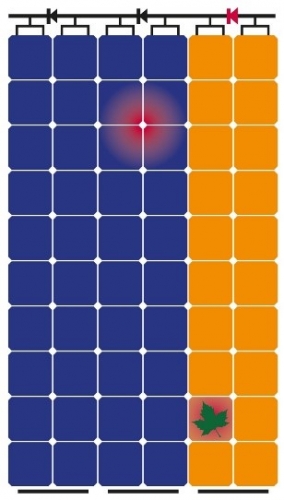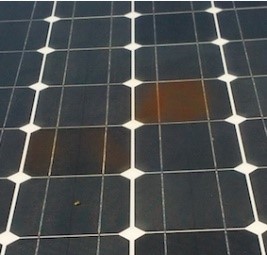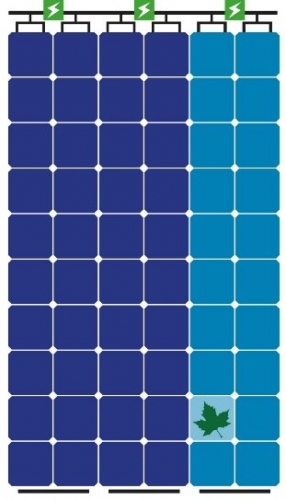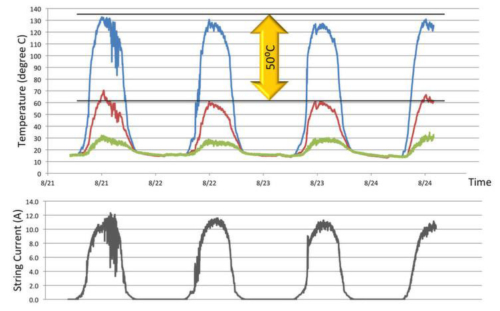Shading losses in PV modules: Cutting-edge e.ISP technology, uniquely patented by Energetica
Shadows are the enemies of efficient photovoltaics. So, from the system operator’s point of view, functional shading management is a significant product advantage.
The new product series from Energetica Photovoltaic Industries have declared war on shading losses. The Austrian company relies on its patented Energetica Integrated Shadow Protection (e.ISP®) to do this. The outcome for operators of photovoltaic (PV) systems is a significantly longer module lifetime, greater safety and higher yield.
How do shading losses occur in photovoltaics?

Hot-spot effects with a conventional solar module. The hot-spot effect means there is a danger of individual solar cells and junction boxes overheating. This increases the risk of fire.
In simple terms, solar energy works like this: as soon as light falls onto PV modules, their solar cells produce electricity. The stronger the light, the more efficient the power generation. Shadows reduce or even reverse the yield of the panels. Even partial shading of modules sometimes means considerable losses. There is a danger of individual solar cells and junction boxes overheating. These components are already exposed to high ambient temperatures anyway in direct sunlight.
A leaf or bird droppings are sufficient for partial shading of the module surface. The shaded solar cells become the electrical resistance and create something similar to a bottleneck, i.e. the output of the weakest module determines the output of the entire string. This reduces the module output which immediately has an adverse effect on the output of the entire photovoltaic system.
Solar cells are usually connected in series. The same amount of current flows through each solar cell. The voltage of the individual solar cells is added together. If the flow of current through the bottleneck mentioned above is restricted, the power that doesn’t pass through the ‘bottleneck’ is converted into heat in the module’s shaded solar cells. This is called the hot-spot effect. The resulting output from the module is then many times lower than it actually might be.
The effects of hot-spot effects in photovoltaic systems
 The shaded cells act like an electrical resistance while the other series-connected cells continue to generate electric voltage. This voltage can exceed the blocking voltage of the shaded cells, break down the blocking voltage and the current can then flow fully. “The voltage drops and is converted into heat which can lead to damage or destruction of the cell due to overheating.” The hot-spot effect means there is a danger of the entire module overheating, thus increasing the risk of fire.
The shaded cells act like an electrical resistance while the other series-connected cells continue to generate electric voltage. This voltage can exceed the blocking voltage of the shaded cells, break down the blocking voltage and the current can then flow fully. “The voltage drops and is converted into heat which can lead to damage or destruction of the cell due to overheating.” The hot-spot effect means there is a danger of the entire module overheating, thus increasing the risk of fire.
How does the e.ISP technology reduce shading loss?
In the event of shading, the Energetica Integrated Shadow Protection (e.ISP®) is designed to intervene to optimise the efficiency of the entire systems and the energy yield when the sun is shining.
A solar module based on crystalline silicon typically consists of 60 to 72 solar cells connected in series. One bypass diode is required for every 20 to 24 cells. The aim is to guard against overheating when in shadow, i.e. hot-spots, and to prevent damage to the solar cells.

The Energetica Integrated Shadow Protection (e.ISP®) intervenes in the event of shading. The e.ISP technology is equipped with intelligent, highly efficient control electronics which generate 10 times less loss: 2.85 watts instead of 21 watts, like standard diodes.
A typical solar module has three such bypass diodes. In the past, Schottky diodes were generally used for this. However, the voltage drop at them is relatively high at 0.5 to 0.7 volts. This equates to a power dissipation of up to seven watts per diode in sunlight; in total up to 21 watts per solar module.
In addition to the losses when operating these bypass diodes, there are also problems with heat dissipation in the case of the plasticjunction boxes. The high temperatures in the junction boxes lead to rapid ageing of the components and to additional thermal stress on the panel foils. The result is more rapid ageing and thermal drifting of the solar cells in front of the junction box. The effect is simply intensified.
Modern solar modules can generate currents of almost 10 A under standardised test conditions (1000 W/m², 25 °C). Under actual operating conditions, they can sometimes be significantly higher.
The e.ISP technologyis equipped with intelligent, highly efficient control electronics which generate 10 times less loss: 2.85 watts instead of 21 watts, like with standard diodes.” The system operator gets up to 18 watts more energy from the shaded photovoltaic module. A factor which significantly increases system profitability.
Testing the e.ISP technology
In a number of tests, the temperatures of two identical PV panels were compared: one was fitted with a Schottky diode, the other with e.ISP technology.
In the test illustrated in the infographic, the PV modules were shaded completely. Under summer conditions, temperatures in the junction boxes are on average 50 °C lower as a result of using the e.ISP technology. In warmer climates the temperature advantage is even more significant.
This protects the solar cells, the laminate and prolongs the lifetime of the modules.
Energetica Photovoltaic Industries has therefore extended its product guarantees to up to 25 years. And we do this because of our conviction and without any hesitation after countless internal and external tests.

The temperatures of two identical PV panels were compared in several tests: One was equipped with a Schottky diode, the other with e.ISP technology. In the experiment shown in the infographic, the PV modules were completely shaded. In summer conditions, the temperatures in the junction boxes are on average 50 ° C lower thanks to the use of e.ISP technology. The temperature advantage is even more pronounced in warmer climates. The blue line shows the temperature of a junction box when using a Schottky diode, the red line the temperature in a junction box when using e.ISP technology. The green line shows the ambient temperature.





